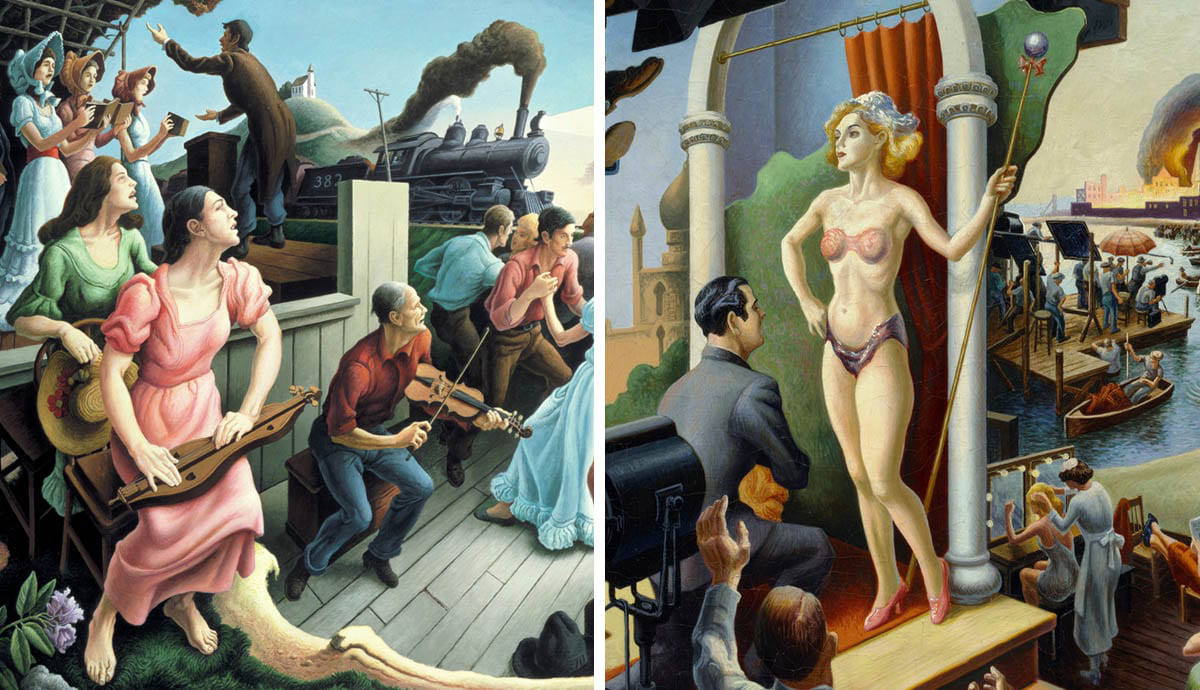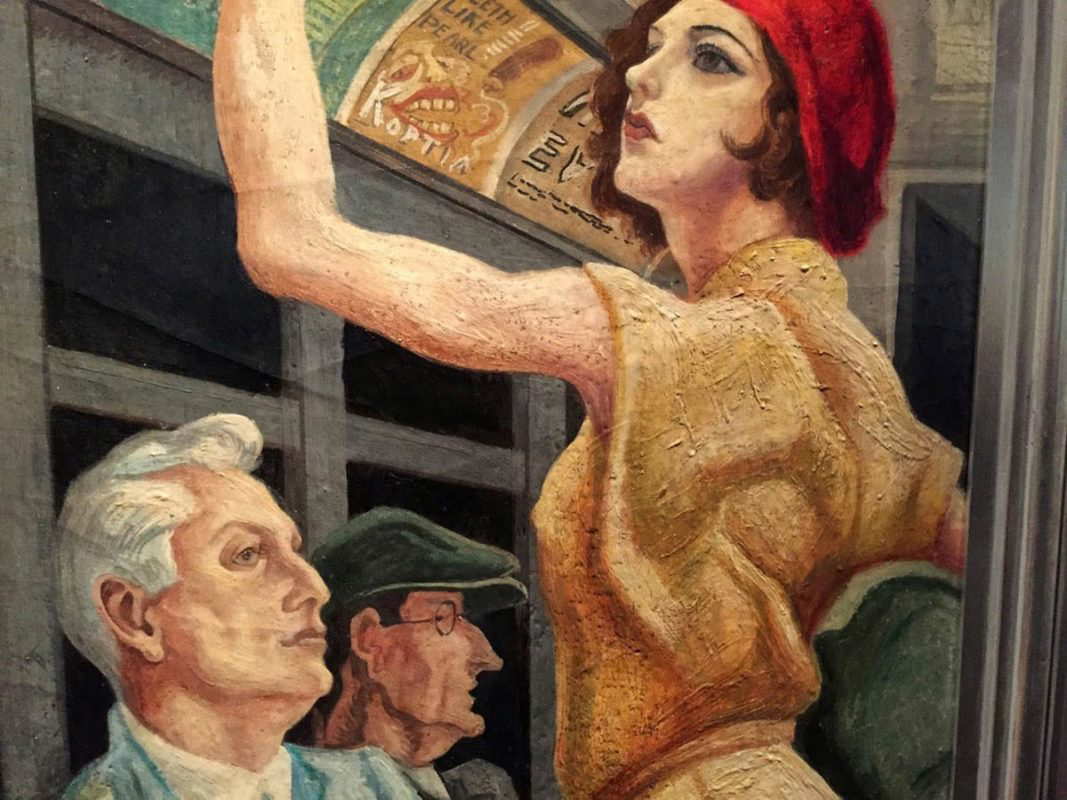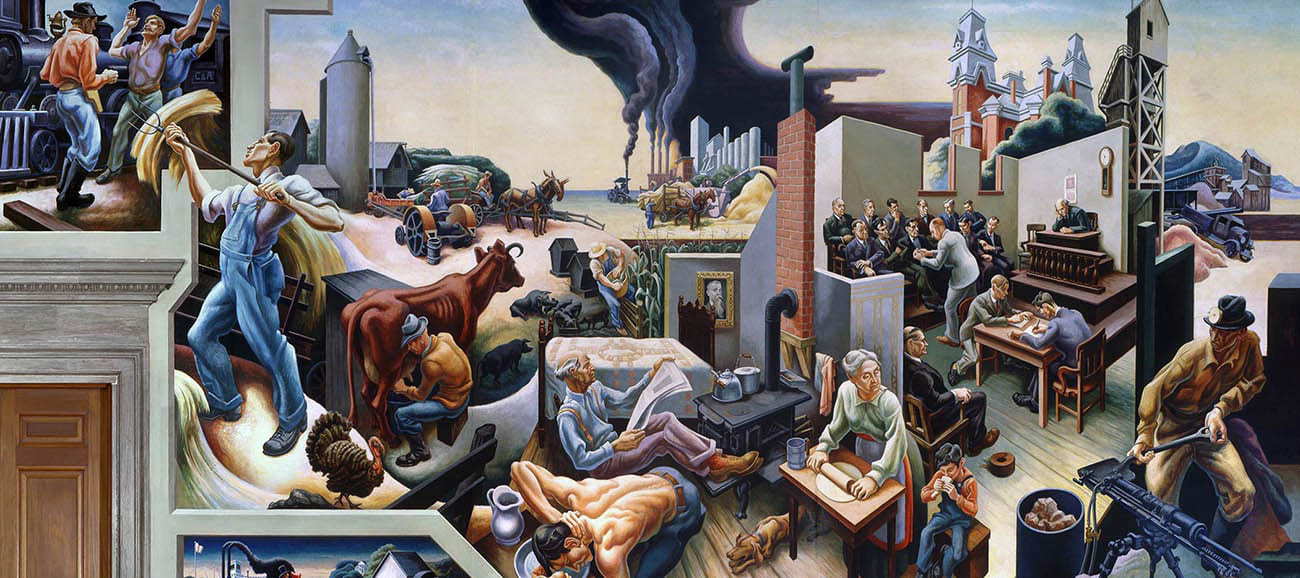
Thomas Hart Benton was an American painter known for his distinctive, flowing painting style. He is credited as one of the founders of American Regionalism alongside Grant Wood and John Steuart Curry. Thomas Hart Benton’s paintings and murals are highly recognizable and capture the essence of American life. He favored rural, Midwestern subjects, but also created works showing more urban scenes fro m his time in New York. While he was primarily a regionalist painter, he also included elements of Synchronism in his work. He had a long career painting and creating murals, until his death in 1975. Here are some facts about the American painter you may not have known.
1. Thomas Hart Benton Was Born In A Small Missouri Town

Thomas Hart Benton was born in Neosho, Missouri, a small town in southwestern Missouri near Joplin, Missouri, in 1889, on April 15th. He was named after his great uncle, Thomas Hart Benton, who was one of Missouri’s first two senators. Benton’s father, Colonel Maecenas Benton, was also a politician for the Democratic party and a lawyer. He was elected as a U.S. Representative four times, from 1897 to 1905. Benton was well-aware of politics from the time he was a small child and his father had always expected him to follow in his footsteps.
His mother, Elizabeth Wise Benton, was interested in arts and culture allowed Benton to explore his artistic abilities while he was younger. She enrolled him in art classes during their time in Washington D.C. at the Corcoran Gallery. The lessons were based on drawing geometric shapes, which Benton found very boring. When he was a teenager, he worked as a cartoonist for the Joplin American, a newspaper based out of Joplin, Missouri.
2. Benton Attended The Art Institute Of Chicago And Académie Julien In Paris

In 1906, at age 17, Benton longed to go to art school, but his father strongly disliked this idea. His father agreed to allow him to attend the Art Institute of Chicago if Benton completed one year at the military school in Alton, Illinois. Benton lasted three months. His father even received a letter from someone at the school declaring it was not the right place for him. He began classes at the Art Institute and found he did not fit in well with the other students, even being expelled once for fighting in the classroom. He was readmitted shortly afterward but was bored with the school and wanted to branch out further.
Get the latest articles delivered to your inbox
Sign up to our Free Weekly Newsletter
He decided to move to Paris to study at Académie Julien in 1908. Benton felt and was treated as inferior by the other artists he met at school, but it did not stop him from enjoying his time outside of school in the city of light. While in Paris, he witnessed the rise of Fauvism and did not care for it. It strengthened his resolve to paint scenes of reality. He returned to Missouri in 1911.
3. He Was An Illustrator For The U.S. Navy During WWI

When America entered WWI, Thomas Hart Benton was working as director of the People’s Gallery and teaching for the Chelsea Neighborhood Association in New York. He enlisted in 1918 and was sent to Norfolk, Virginia Naval Base. His job was to make drawings of what he saw happening around the base, which allowed him access to many areas where he could observe people working. He furthered his devotion to realism and strived to show the working man and machinery in an honest way, not an idealized fashion. The watercolors he produced during his time in the Navy were put on display at the Daniel Galleries in New York. After he was discharged in 1919, he returned to New York.
4. The American Painter Was Jackson Pollock’s Teacher

While teaching in New York, a young Jackson Pollock enrolled in Thomas Hart Benton’s class in 1930. The two men became friends as Benton took Pollock under his wing, teaching his about classical painting which Pollock was unfamiliar with. Pollock was there to witness Benton’s rise to popularity as more people began to take notice of his work and even wrote to his father about this. Pollock spent a lot of time with the Benton family, even joining them on their vacations to Martha’s Vineyard. In 1934, Pollock posed for Benton’s painting The Ballad of the Jealous of Lone Green Valley as the figure playing the mouth harp.
Eventually, Benton moved from New York to Kansas City and Pollock began experimenting with abstraction, an art style which Benton detested. As the popularity of regionalism waned and interest in abstraction began to sky-rocket, Pollock became one of the most famous American painters of the time and Benton was pushed backstage. When asked about Benton’s influence on him, Pollock would state the famous artist had taught him something to rebel against.
5. He Was Head Of Kansas City Art Institute’s Painting Department

Benton was invited to head the painting department at the Kansas City Art Institute in 1935. He agreed to the position and moved his wife and son from New York to Kansas City. The city and the school were excited at his arrival. While he taught at the school, he completed numerous masterpieces, such as Hollywood and Persephone.

These famous Thomas Hart Benton paintings can be seen prominently displayed in the Nelson-Atkins Museum of Art in Kansas City, Missouri. His time working at the school was short, only lasting 6 years. In 1941, he was fired after he made several homophobic remarks about the staff at the Nelson-Atkins Museum of Art, which was closely connected to the Kansas City Art Institute. Despite his dismissal, he remained in Kansas City and continued working from there for the rest of his life.
6. He Had Some Interesting Run-Ins With Magazines

During the 1930s, Thomas Hart Benton was approached by two major publications, TIME Magazine in 1934 and Life Magazine in 1937 and 1969. In 1934, Thomas Hart Benton was the first artist to ever appear on the cover of TIME Magazine. The article about him was called U.S. Scene and covered his part in the regional art movement. It was published on December 24th, 1939.
In 1937, Life Magazine commissioned a large painting from Benton on the subject of Hollywood, even paying for him to take a trip there over the summer of that year. His famous painting, Hollywood, was completed in 1938. When Life Magazine first saw the work, they immediately disapproved and wanted nothing to do with it, but the popularity of the work changed their tune and they included it in their spread about Hollywood. In 1969, Life published an article by Michael McWhirter called “Painter Tom Benton is Still at War with Bores and Boobs at 80” about the still outspoken, aging American painter.
7. Benton’s Mural With Ku Klux Klan Members Still Sparks Controversy

Thomas Hart Benton was commissioned to create a large mural for the state of Indiana in 1932 and it was presented at the 1933 Chicago World’s Fair. The mural, A Social History of Indiana, is made up of 22 large panels, spanning 250 ft in total, representing the state of Indiana. He spent time traveling around Indiana interviewing residents of the state before starting on the large project. From his conversations, he was surprised to find out things he had not expected, such as the prominence of the Ku Klux Klan in Indiana and a mining strike called Terre Haute.
He decided to include these things in his mural because of how often they were brought up in his interviews. The inclusion of the Ku Klux Klan and the strikers brought heavy criticism when the mural was exhibited at the World’s Fair, but this didn’t stop the mural from being one of the most popular exhibits. Midwesterners were thrilled to see a representation of themselves in art.

The panels are now on display at the University of Indiana Bloomington. They still garner much controversy and demands for their removal, or at least the removal of the panel showing the Ku Klux Klan named “Parks, the Circus, the Klan, the Press,” are still being brought forward today. In 2017, students passed around a petition calling for its removal to which the university declared the lecture hall where it hangs will no longer be used for classes.
8. He Created A Mural For Missouri’s Capitol Building

Detail from A Social History of the State of Missouri by Thomas Hart Benton, 1936, via the Missouri State Capitol, Jefferson City
In 1935, Thomas Hart Benton was commissioned to create a mural for a lounge in the Missouri State Capitol building. He was paid $16,000 for A Social History of the State of Missouri and it was completed in 1935. Like many Thomas Hart Benton paintings, the mural was not exempt from public disapproval. His mural included figures of Missouri lore like Jesse James, Frankie and Johnnie from the popular saloon song of the time, and Huckleberry Finn. One figure in his mural showed a likeness to the infamous corrupt political boss from Kansas City, Tom Pendergast. A few years after the mural’s completion, when Pendergast was arrested for tax evasion, someone took it upon themselves to add his prison number to the back of the figure in question.
President Truman, a friend of Benton’s, was under the impression Benton orchestrated this prank and was angry at him for many years till the misunderstanding was corrected. Despite these few cameos, the people of Missouri were the main stars of the work, which still angered some of the public, who claimed there were not enough famous Missourians included. Benton responded to this critic with “The ordinary mule had more to do with the growth of this state than any number of favored sons.”
9. Benton Was An Avid Harmonica Player

One of Thomas Hart Benton’s many passions outside of painting was folk music. In 1933, he began learning how to play the harmonica and read music. He even created a new tablature system for recording harmonica notation, which later became the standard. Benton enjoyed playing music with his family and even recorded an album in 1941 titled “Saturday Night at Tom Benton’s” with his son, who played the flute. His large collection of folk albums and sheet music still remains in his Kansas City home. He collected these as he traveled around the country making sketches and taking notes for numerous different artworks. This connection to music is evident in many of his paintings and was another way for him in which he related to his subject matter.
10. You Can Visit Thomas Hart Benson’s Home In Kansas City

Thomas Hart Benton moved into his home on Belleview Street in Kansas City, Missouri in 1939 and lived there until his death. One of the most important features of the home to Benton was the carriage house next to the main house. Part of it was converted into a studio where he could work on his masterpieces in peace. On the evening of January 19, 1975, Benton returned to his studio after dinner to continue work on The Origins of Country Music, a mural he was commissioned to create for the Country Music Foundation of America. His wife, Rita, realized sometime later that her husband was working too late and she went to fetch him from his studio. Benton was dead, lying on the floor next to a chair that had been facing his final mural.

The house and studio are preserved in the way that Benton left them in 1975. The property was declared a state historic site in 1977 and is managed by the Missouri Department of Natural Resources. Visitors can tour the house and studio and even pick up a copy of Rita’s famous spaghetti recipe. There are still many of his original paintings and even some of his sculptures placed around the home.








